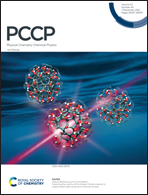Vibrational energy relaxation of a diatomic molecule in a superfluid helium nanodroplet: influence of the nanodroplet size, interaction energy and energy gap†
Abstract
The influence of the nanodroplet size, molecule–helium interaction potential energy and ν = 1 − ν = 0 vibrational energy gap on the vibrational energy relaxation (VER) of a diatomic molecule (X2) in a superfluid helium nanodroplet [HeND or (4He)N; finite quantum solvent at T = 0.37 K] has been studied using a hybrid quantum approach recently proposed by us and taking as a reference the VER results on the I2@(4He)100 doped nanodroplet (Vilà et al., Phys. Chem. Chem. Phys., 2018, 20, 118, which corresponds to the first theoretical study on the VER of molecules embedded in a HeND). This has allowed us to obtain a deeper insight into the vibrational relaxation dynamics. The nanodroplet size has a very small effect on the VER, as this process mainly depends on the interaction between the molecule and the nanodroplet first solvation shell. Regarding the interaction potential energy and the energy gap, both factors play an important and comparable role in the VER time properties (global relaxation time, lifetime and transition time). As the former becomes stronger the relaxation time properties decrease in a significant way (their inverse follows a linear dependence with respect to the ν = 1 − ν = 0 coupling term) and they also decrease in a significant manner when the energy gap diminishes (linear dependence on the ν = 1 − ν = 0 energy difference). We expect that this study will motivate further work on the vibrational relaxation process in HeNDs.



 Please wait while we load your content...
Please wait while we load your content...